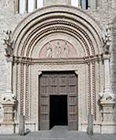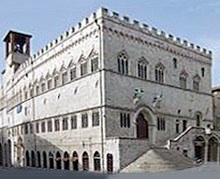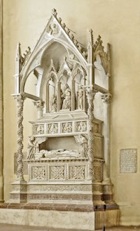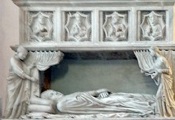Ambrogio Maitani came from Siena. While his brother, Lorenzo Maitani, established his career as the leader of the team working on the Duomo of Orvieto, Ambrogio established his in Perugia, where he was documented as city architect in the period 1317-46. In 1319, the Perugian authorities requested from their peers in Orvieto that Lorenzo Maitani might be allowed to stay in Perugia for a period, and documents indicate that he remained there until 1321. The brothers presumably worked together at this time. Their association also seems to have extended to Orvieto: in 1337, the commune there made a payment to him and to two of his nephews, Vitale and Antonio.
[Fortress (1326) at Città della Pieve]
Perugia
Work on Palazzo dei Priori (1317-46)


Ambrogio Maitani probably supervised the project to extend Palazzo dei Priori from 1317, when he was appointed as city architect. The palace, which had suffered a fire in 1315, was extended in two phases:
-
✴His first task was to extend the palace along what is now Corso Vannucci in order to provided more accommodation for the priors. This phase included the construction of a monumental entrance to the atrium of the new palace (the Portale dei Santi Patroni - see below). In 1326, he began the construction of the steps to the entrance to the priors’ residence (the first room of which later became the Sala dei Notai). The priors moved into their new accommodation shortly thereafter.
-
✴In 1331, he turned his attention to the accommodation of the Capitano del Popolo. He extended the palace in Piazza Grande, incorporating the deconsecrated church of San Severo (in 1333), the Torre di Madonna Dialdana (behind it, in Via della Gabbia) and other adjacent buildings as far as the Palazzo dei Priori.
Work on Sant’ Ercolano (1326)
Ambrogio Maitani is documented at work on Sant’ Ercolano in 1326.
Work of the City Walls and Gates (1326-42)
In 1326, the Commune commissioned Ambrogio Maitani to repair a “turrione vetus seu penna .... iusta portam muri veteris porte Sancti Angeli”. While some writers suggest that this refers to the present porta Sant’ Angelo, Ugolino Nicolini (referenced in the pages on the gates) has shown that this document refers to a tower that belonged to the della Penna family near the ancient gate that is now called Arco Etrusco rather than, as other sources sometimes assert, to the later Porta Sant' Angelo at the end of Corso Garibaldi.
The extension of the city walls in the early 14th century to incorporate Porta Sant’ Angelo, which might well have included the restoration of this pre-existing gate, is attributed to Ambrogio Maitani. It seems to have occurred in three phases:
-
✴from Porta Bulagaio, around the Convento di Sant’ Agostino to Porta dello Sperandio (which was built at an unknown date and restored in 1329);
-
✴from Porta dello Sperandio to Porta Sant’ Angelo; and
-
✴from Porta Sant’ Angelo around the depression known as la Conca to Porta Vecchia della Conca.
The foundations of this last section of the walls were laid in 1327 and the wall itself was built in 1338-42.
Sculpture attributed to Ambrogio Maitani
There is no documentary evidence that Ambrogio Maitani was a sculptor, and no surviving sculptures can be securely attributed to him. Nevertheless, it is likely that he possessed the necessary skills. The following works of sculpture in Perugia are sometimes attributed to him.
Patron Saints of Perugia (early 14th century)



These originally polychrome marble figures lunette above the Portale dei Santi Patroni (the entrance to the Palazzo dei Priori) probably represent SS Herculanus, Laurence and Constantius; these saints were named together as the patron saints of Perugia in 1316. The figures were removed for restoration in 1993 and moved to the Galleria Nazionale., while copies replaced them in the original location.
Madonna di Sant' Agostino (early 14th century)

The Madonna is modelled as a full-length figure in regal costume, wearing a crown and carrying the baby Jesus on her hip. He is also regally dressed, and holds a bird in His right hand (probably a finch, which is a symbol of the Passion). Recent restoration has revealed the original polychrome decoration, which is in a good state of preservation that is unusual in a work of this age.
Monument to Pope Benedict XI (early 14th century)

The Dominican Pope Benedict XI, who died in Perugia in July 1304, was buried in San Domenico Veccchio. He wished to be buried “ne in alto poneretur, sed sub terra, ex magna humilitate quam habebat” (not up high, but under the ground, out of his great humility). It seems that the wishes of Benedict XI were initially honoured: documents prepared in connection with his beatification in 1773 record that he was initially buried, like the friars themselves, in the pavement of the choir of the church.
According to the Chronicle of St Antoninus of Florence, the decision to erect a monument (monument to Pope Benedict XI) was taken some time after the death of Benedict XI, when miracles were reported at his grave. The document of 1773 mentioned above also said that it was built “some years later”: this source attributed the commissioning of it to the Dominican Cardinal Nicolò Alberti (died 1321), the ex-bishop of Spoleto, whom Benedict XI had raised to the purple in 1303. It seems likely that the translation of the relics to this new monument in the choir was associated with a an ultimately unsuccessful bid for the canonisation of Benedict XI.
The precise time at which the monument was built is a matter of dispute (see the references below):
-
✴According to Giorgio Vasari, “Benedict XI having died in Perugia, a summons was sent to [Giovanni Pisano], who ... made a tomb of marble for that Pontiff in [San Domenico Vecchio]. Few if any scholars accept the attribution, but a number subscribe to the implied dating to a time before ca. 1315, when Giovanni Pisano died.
-
✴A second group date the monument on stylistic grounds to the late 1320s. Some among this group attribute it to Ambrogio Maitani.
According to an account written in 1728, the monument was originally on the right wall of San Domenico Vecchio, where it was approached by three steps of red marble, protected by a metal grill and surmounted by a cross of gold. It was moved to the left transept of San Domenico in the 18th century, at which point the relics were also installed behind the grate above the high altar. It was restored and re-assembled in its current location (on the right wall of the Cappella degli Apostoli) in 1959. The original inscription is separately displayed to the right of the monument.


Benedict XI is depicted twice on his monument:
-
✴He kneels in the tripartite upper tabernacle as St Dominic presents him to the Madonna and Child, while a bishop saint looks on from the right.
-
✴He lies in effigy on the sarcophagus, behind curtains drawn apart by angels, under a frieze that depicts six saints in relief (four above and one at each side): these include SS Peter, Paul and Peter Martyr.
The relief at the cusp of the surrounding tabernacle depicts Christ imparting His blessing.
Read more:
For the earlier dating of the monument to Benedict XI, see for example:
F. Baldelli and C. Fratini, “Il Monumento Funebre di Papa Benedetto XI nella Basilica di San Domenico a Perugia nel Contesto della Scultura Funeraria Italiana nella Prima Metà del XIV Secolo”, in
A. Vignanò (Ed.), “Benedetto XI: Papa Domenicano (1240-1304)”, (2006) Florence
F. Baldelli and C. Fratini, “Il Monumento Funebre a Papa Benedetto XI”, in
A. Vignanò (Ed.), “Benedetto XI: Papa Domenicano (1240-1304)”, (2006) Florence
For the later dating of the monument, see for example:
J. Gardner, “The Tomb and the Tiara: Curial Tomb Sculpture in Rome and Avignon in the Later Middle Ages”, (1992) Oxford
For the attribution of the works of sculpture mentioned above to Ambrogio Matiani (which implies the later dating of the monument of Benedict XI):
E. Lunghi, “Ambrogio Maitani”, Schedules 28 and 29 in:
C. Bon Valsassina and V. Garibaldi (Eds), “Dipinti, Sculture e Ceramiche della Galleria Nazionale dell' Umbria: Studi e Restauri” (1994) Florence
Return to Art in: Perugia.
Return to “Foreign” Architects in Umbria.



